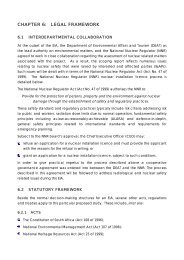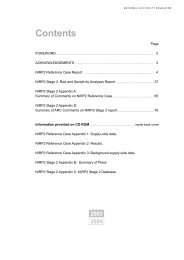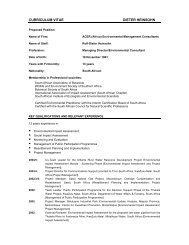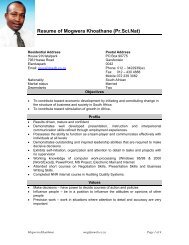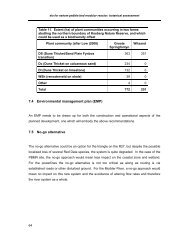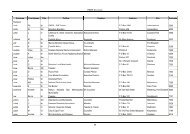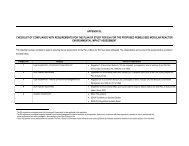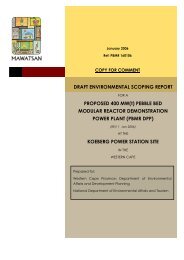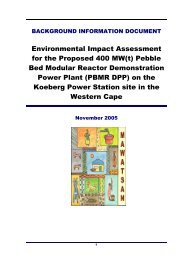Appendix AI - Oceanography FINAL.pdf - PBMR
Appendix AI - Oceanography FINAL.pdf - PBMR
Appendix AI - Oceanography FINAL.pdf - PBMR
You also want an ePaper? Increase the reach of your titles
YUMPU automatically turns print PDFs into web optimized ePapers that Google loves.
Pebble Bed Modular Reactor Demonstration Power Plant<br />
Environmental Impact Assessment<br />
Assessment of Oceanographic Impacts<br />
Compiled by Dr T.B. Robinson<br />
Tel: (021) 671 6724<br />
trobins@botzoo.uct.ac.za
Table of Contents<br />
Executive Summary<br />
i<br />
1. Introduction 2<br />
2. Methodology 2<br />
3. Impact assessment 2<br />
3.1 Potential impacts during normal operations 2<br />
3.1.1 Flooding from the sea 2<br />
3.2 Interruption in supply of marine cooling water 3<br />
3.3 Seawater temperature 5<br />
3.2 Potential impacts as a result of non-nuclear accidents 12<br />
3.3 Potential impacts of a nuclear accident 12<br />
4. Conclusions and recommendations 12
Executive Summary<br />
This report offers a review of the report prepared by Prestedge Retief Dresner<br />
Wijnberg (Pty) Ltd and an assessment of oceanographic impacts surrounding the<br />
proposed <strong>PBMR</strong> DPP during the construction, commissioning and operational phases<br />
of development.<br />
The threat of flooding from the sea during all phases of the proposed development<br />
stems from extreme waves, extreme water levels and tsunamis. Should the <strong>PBMR</strong><br />
DPP be constructed at least 8m above mean sea level, there is no risk of flooding<br />
under the current parameters.<br />
Exposure of cooling water intake pipes, damage to cooling water intake pipes,<br />
sedimentation within the mouth of the intake basin and blockage of cooling water<br />
intake pipes by sand, oil slicks, debris or marine fauna and flora may threaten the<br />
supply of seawater for cooling purposes. These threats will be encountered during the<br />
commissioning and operational phase of the development.<br />
The temperature of seawater taken up for cooling purposes has implications for the<br />
efficiency of the cooling system. It is anticipated that the likelihood of the sea<br />
temperature increasing above the 42C margin is extremely low<br />
It is concluded that the proposed <strong>PBMR</strong> DPP are not expected to be significantly<br />
impacted by the oceanography of the surrounding area. Additionally, the development<br />
is not anticipated to affect the oceanographic characteristics of the marine<br />
environment.<br />
1
1. Introduction<br />
SHE Cape Environmental were appointed by Arcus Gibb to prepare a specialist report<br />
on Meteorology and <strong>Oceanography</strong> aspects of the Koeberg <strong>PBMR</strong> DPP. Prestedge<br />
Retief Dresner Wijnberg (Pty) Ltd were in turn appointed by SHE Cape<br />
Environmental to provide specialist oceanographic input into this study. As<br />
engineering specialists Prestedge Retief Dresner Wijnberg (Pty) Ltd described<br />
potential oceanographic impacts on the <strong>PBMR</strong> DPP development but were unable to<br />
assess the implications of these impacts. Due to unforeseen circumstances SHE Cape<br />
Environmental have not been able to conduct an assessment of the impacts identified<br />
by Prestedge Retief Dresner Wijnberg (Pty) Ltd. As such, this report serves to review<br />
the report prepared by Prestedge Retief Dresner Wijnberg (Pty) Ltd and assess all<br />
possible environmental impacts identified within that report.<br />
2. Methodology<br />
The assessment provided in this report is based on the potential oceanographic<br />
impacts identified within the report provided by Prestedge Retief Dresner Wijnberg<br />
(Pty) Ltd (Attached here to as <strong>Appendix</strong> 1).<br />
3. Impact assessment<br />
3.1 Potential impacts during normal operations<br />
3.1.1 Flooding from the sea<br />
(a) Extreme waves<br />
Using wave data collected at Koeberg Nuclear Power Station (KNPS) mathematical<br />
modelling (using the widely accepted Weibull distribution method) was used to assess<br />
the return period of extreme waves (See <strong>Appendix</strong> 1 for more detail). These best fit<br />
predictions indicate that if the <strong>PBMR</strong> DPP is build at the same elevation as KNPS<br />
(i.e. 8 m above mean sea level (MSL)) flooding from extreme waves is very unlikely.<br />
(b) Extreme water levels<br />
Extreme water levels are influenced by wave action, tides, meteorological effects (e.g.<br />
onshore winds, low barometric pressures, shelf waves and edge waves) and tsunamis.<br />
Based on the predictions of Prestedge Retief Dresner Wijnberg the extreme water<br />
level that would cause flooding of the power station from the sea has a recurrence<br />
interval of 1 in 10 6 years at the 68% confidence level and would be 6.09 m above<br />
2
MSL. These estimates are considered reliable as two separate studies arrived at the<br />
same figure (See <strong>Appendix</strong> 1).<br />
Accompanying global climate, sea levels are anticipated to rise over the long-term. It<br />
is predicted that global sea level will rise at a rate of about 4 mm/year to reach<br />
between 0.22 and 0.44 m above 1990 levels by 2090 (<strong>Appendix</strong> 1). At this rate of<br />
increase extreme water levels are not anticipated to threaten the <strong>PBMR</strong> DPP.<br />
(c) Tsunamis<br />
When considering potential of flooding due to a Tsunami it is recommended that the<br />
maximum credible tsunami run-up (i.e. 4 m above still water level) be combined with<br />
the level of highest astronomical tide (i.e. 1.20 m above MSL based on the 2005 Tide<br />
Tables). Under such conditions a maximum flood level of 5.20 m above MSL is<br />
predicted. As the reoccurrence interval of the highest astronomical tide is 1 in 18.6<br />
years the likelihood of a tsunami co-occurring with such a tide is small. Nonetheless,<br />
should this occur a flood level of 5.20 m will not affect the <strong>PBMR</strong> DPP should it be<br />
build at an elevation of 8 m above MSL (as is KNPS).<br />
The above assessment of the threat of flooding from the sea from extreme waves,<br />
extreme water levels and tsunamis applies throughout the construction,<br />
commissioning and operational phase of the development<br />
3.1.2 Interruption in supply of marine cooling water<br />
(a) Exposure of cooling water intake pipes<br />
It is proposed that the <strong>PBMR</strong> DPP will obtain marine cooling water from the CRF-<br />
SEC backup line of KNPS. As the centre line of the openings to the backup line occur<br />
at -1.75m MSL and the uptake pipe has a diameter of 1.2m, intake water will be<br />
totally cut off at a level of -2.35m.<br />
Additional consideration should be given to the potential of exposure of cooling water<br />
intake pipes by tsunamis. Under conditions of the maximum credible tsunami<br />
described above, the draw down of water at the site of the proposed development is<br />
predicted to reach 4 m below still water level. Should this occur at lowest<br />
astronomical tide the extreme low water level could be -4.9 MSL.<br />
3
(b) Damage to cooling water intake pipes<br />
As the cooling water abstraction pipe for both KNPS and the <strong>PBMR</strong> DPP are located<br />
within the intake basin, damage to the breakwaters of the basin may result in damage<br />
to the pipes and subsequent reduction in volume of cooling water. In order to<br />
minimise the risk of such damage from storms or collisions with ships, the<br />
breakwaters were designed according to a ‘zero percent damage’ criteria (as defined<br />
in the Koeberg Site Safety Report). As a result, damage to the breakwater would not<br />
jeopardise the immediate availability of water in the basin and as such no significant<br />
threat is posed to the supply of emergency cooling water.<br />
(c) Sedimentation<br />
Regular monitoring since the construction of KNPS has shown that no long-term<br />
erosion or accretion of the seabed or surrounding beach has been caused by the<br />
building of the intake basin and breakwaters. Additionally, repair of only minor<br />
erosion damage has been required on the south side of the basin.<br />
Silting-up of the intake basin entrance occurs at a rate of 132 000 m 3 /year and in the<br />
last 26 years dredging of encroaching sediment has been required only seven times.<br />
Based on this tack record it is considered unlikely that sedimentation will result in<br />
blocking of the entrance to an extent which would impede the inflow of cooling water.<br />
(d) Blockage of cooling water intake pipes<br />
A number of structural and operational aspects of the pumphouse and water intake<br />
system to be used by the <strong>PBMR</strong> are designed to minimise the possibility of blockage<br />
of intake water (see <strong>Appendix</strong> 1 for details). The threat of blockage of the cooling<br />
water system stems predominantly from sand, oil slicks, debris and marine fauna and<br />
flora. Current mitigation measures have reduced the chance of a significant blockage<br />
occurring. However, in the last six years jellyfish blooms have had dramatic effects on<br />
cooling water intake on three occasions. A current study is investigating this impact in<br />
detail and additional mitigation measures are presently being implemented.<br />
The interruption in supply of marine cooling water may impact on the <strong>PBMR</strong> DPP<br />
during the commissioning and operational phases.<br />
4
3.1.3 Seawater temperature<br />
As the cooling system of the <strong>PBMR</strong> DPP ultimately relies on heat transfer from the<br />
hot reactor to cold seawater, the temperature of seawater taken up has implications for<br />
the efficiency of cooling. By design the <strong>PBMR</strong> DPP requires that the temperature of<br />
uptake water does not exceed 42 ºC, by comparison KNPS requires that the<br />
temperature of cooling water remains below 23 ºC. Mathematical modelling based on<br />
daily temperature measurements collected at KNPS over twenty years indicates that<br />
the return period of a seawater temperature above 22 ºC is 40 years while the return<br />
period of 23 ºC seawater is 133 years. It is thus clear that the risk of uptake water<br />
exceeding 42 ºC is not considerable but will have an effect on efficiency. It is<br />
anticipated that the likelihood of the sea temperature increasing above the 42ºC<br />
margin is extremely low. Therefore, no impacts are anticipated.<br />
5
Table 1: Potential oceanographic impacts during normal operations<br />
Impact Nature Intensity Extent Duration Probability Non-<br />
Reversibility*<br />
Impact 1: Flooding due to extreme waves Negative High Local Short term Improbable Not considered<br />
Mathematical modelling of data collected over<br />
relevant<br />
seven years indicates that extreme waves are<br />
very unlikely to cause flooding at the site of the<br />
proposed development.<br />
Irreplaceability*<br />
Not considered<br />
relevant<br />
Confidence<br />
High<br />
With Mitigation<br />
Should the <strong>PBMR</strong> DPP be built at least 8m above MSL no mitigation measures are considered necessary<br />
Impact 2: Flooding due to extreme water<br />
levels<br />
The probability of flooding of the power station<br />
due to extreme water levels is considered low as<br />
this would require a water level of 6.09 m above<br />
MSL and has a recurrence interval of 1 in 10 6<br />
years.<br />
Negative High Local Short term Improbable Not considered<br />
relevant<br />
Not considered<br />
relevant<br />
High<br />
With Mitigation<br />
Should the <strong>PBMR</strong> DPP be built at least 8m above MSL no mitigation measures are considered necessary<br />
Impact 3: Flooding due to Tsunamis<br />
The maximum credible tsunami for the<br />
proposed site is predicted to be 4 m above still<br />
water level. When combined with the level of<br />
highest astronomical tide (i.e. 1.20 m above<br />
MSL), a maximum flood level of 5.20 m above<br />
MSL could occur. While the probability of such<br />
a tide co-occurring with a tsunami is low, a<br />
water level of this height will not flood the<br />
<strong>PBMR</strong> DPP if it is built 8 m above MSL.<br />
Negative High Local Short term Improbable Not considered<br />
relevant<br />
Not considered<br />
relevant<br />
High<br />
With Mitigation<br />
Should the <strong>PBMR</strong> DPP be built at least 8m above MSL no mitigation measures are considered necessary<br />
6
Impact Nature Intensity Extent Duration Probability Non-<br />
Reversibility*<br />
Impact 4: Exposure of cooling water intake Negative High Local Short term Improbable Not considered<br />
pipes under tsunami conditions<br />
relevant<br />
Under conditions of the maximum credible<br />
tsunami, the draw down of water at the site of<br />
the proposed development is predicted to reach<br />
4 m below still water level. Should this occur at<br />
lowest astronomical tide the extreme low water<br />
level could be -4.9 MSL.<br />
Irreplaceability*<br />
Not considered<br />
relevant<br />
Confidence<br />
High<br />
With Mitigation<br />
Under such unlikely conditions as described<br />
above, alternative cooling water would have to<br />
be sourced in order to maintain operation of the<br />
cooling system.<br />
Impact 5: Damage to intake basin<br />
The intake basin is designed in such a way that<br />
damage to the breakwaters would not jeopardise<br />
the integrity of the intake pipes or the<br />
immediate availability of water in the basin. As<br />
such no significant threat is posed to the supply<br />
of emergency cooling water.<br />
Negative High Local Short term Improbable Not considered<br />
relevant<br />
Negative High Local Short term Improbable Not considered<br />
relevant<br />
Not considered<br />
relevant<br />
Not considered<br />
relevant<br />
High<br />
High<br />
With Mitigation<br />
No mitigation measures required<br />
Impact 6: Erosion or accretion of<br />
surrounding sediment<br />
As no long-term erosion or accretion of the<br />
seabed or surrounding beach has been caused by<br />
the building of the intake basin and breakwaters<br />
since the construction of KNPS. As such it is<br />
highly unlikely that this will occur in the future.<br />
With Mitigation<br />
Negative Medium Local Short term Improbable Low No High<br />
No mitigation measures required<br />
7
Impact Nature Intensity Extent Duration Probability Non-<br />
Reversibility*<br />
Irreplaceability*<br />
Confidence<br />
Impact 7: Sedimentation within the intake<br />
basin<br />
As dredging of encroaching sediment has been<br />
required only seven times in the last 26 years it<br />
is considered unlikely that sedimentation will<br />
result in blocking of the entrance to an extent<br />
which would impede the inflow of cooling<br />
water.<br />
Negative High Local Short term Improbable Not considered<br />
relevant<br />
Not considered<br />
relevant<br />
High<br />
With Mitigation<br />
No mitigation measures required<br />
Impact 8: Blockage of cooling water intake<br />
pipes<br />
The threat of blockage of the cooling water<br />
system stems predominantly from sand, oil<br />
slicks, debris and marine fauna and flora. The<br />
structural and operational mitigation measures<br />
currently applied to the pumphouse and water<br />
intake system to be used by the <strong>PBMR</strong> are<br />
deemed sufficient to minimise the possibility of<br />
blockage of intake water.<br />
Negative High Local Short term Improbable Not considered<br />
relevant<br />
Not considered<br />
relevant<br />
High<br />
With Mitigation<br />
No further mitigation measures are required<br />
*These categories are not considered relevant to this particular study as it considers the impact of oceanographic features on the design and placement etc of the <strong>PBMR</strong> DPP<br />
8
Table 2: Consequence of oceanographic impacts during normal operations<br />
Impact<br />
Impact 1: Flooding due to<br />
extreme waves<br />
Consequence Probability Confidence<br />
Low Improbable High<br />
With mitigation<br />
Impact 2: Flooding due to<br />
extreme water levels<br />
With mitigation<br />
Impact 3: Flooding due to<br />
Tsunamis<br />
With mitigation<br />
Impact 4: Exposure of cooling<br />
water intake pipes under<br />
tsunami conditions<br />
Should the <strong>PBMR</strong> DPP be built at least 8m above MSL no<br />
mitigation measures are considered necessary<br />
Low Improbable High<br />
Should the <strong>PBMR</strong> DPP be built at least 8m above MSL no<br />
mitigation measures are considered necessary<br />
Low Improbable High<br />
Should the <strong>PBMR</strong> DPP be built at least 8m above MSL no<br />
mitigation measures are considered necessary<br />
Low Improbable High<br />
With mitigation Low Improbable High<br />
Impact 5: Damage to intake<br />
basin<br />
With mitigation<br />
Impact 6: Erosion or accretion<br />
of surrounding sediment<br />
With mitigation<br />
Impact 7: Sedimentation within<br />
the intake basin<br />
With mitigation<br />
Impact 8: Blockage of cooling<br />
water intake pipes<br />
With mitigation<br />
Low Improbable High<br />
No mitigation measures required<br />
Low Improbable High<br />
No mitigation measures required<br />
Low Improbable High<br />
No mitigation measures required<br />
Low Improbable High<br />
No mitigation measures required<br />
Table 3: Significance of potential oceanographic impacts during normal operations<br />
Impact Consequence Probability Significance Confidence<br />
Impact 1: Flooding due to<br />
extreme waves<br />
Low Improbable Low High<br />
With mitigation<br />
Impact 2: Flooding due to<br />
extreme water levels<br />
No mitigation measures required<br />
Low Improbable Low High<br />
9
With mitigation<br />
Impact 3: Flooding due to<br />
Tsunamis<br />
With mitigation<br />
Impact 4: Exposure of cooling<br />
water intake pipes under<br />
tsunami conditions<br />
No mitigation measures required<br />
Low Improbable Low High<br />
No mitigation measures required<br />
Low Improbable Low High<br />
With mitigation Low Improbable Low High<br />
Impact 5: Damage to intake<br />
basin<br />
With mitigation<br />
Impact 6: Erosion or accretion<br />
of surrounding sediment<br />
With mitigation<br />
Impact 7: Sedimentation within<br />
the intake basin<br />
With mitigation<br />
Impact 8: Blockage of cooling<br />
water intake pipes<br />
With mitigation<br />
Low Improbable Low High<br />
No mitigation measures required<br />
Low Improbable Low High<br />
No mitigation measures required<br />
Low Improbable Low High<br />
No mitigation measures required<br />
Low Improbable Low High<br />
No mitigation measures required<br />
10
3.2 Potential impacts as a result of non-nuclear accidents and incidents<br />
No non-nuclear accidents are anticipated to affect the oceanography of the<br />
surrounding area.<br />
3.3 Potential impacts of a nuclear accident<br />
The oceanography of the surrounding area is not anticipated to cause or be affected by<br />
a nuclear accident.<br />
4. Conclusions and recommendations<br />
The threat of flooding of the <strong>PBMR</strong> DPP originates from extreme waves, extreme<br />
water levels and tsunamis. Although present during all stages of the development, this<br />
threat is, however, not significant.<br />
The temperature of seawater taken up for cooling purposes has implications for the<br />
efficiency of the cooling system. It is anticipated that the likelihood of the sea<br />
temperature increasing above the 42C margin is extremely low<br />
It is concluded that construction, commissioning and operation of the proposed<br />
<strong>PBMR</strong> DPP are not expected to be significantly impacted by the oceanography of the<br />
surrounding area. Additionally, the development is not anticipated to affect the<br />
oceanographic characteristics of the marine environment.<br />
11



